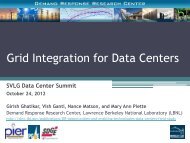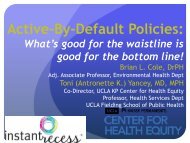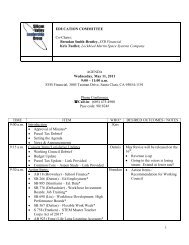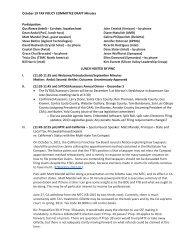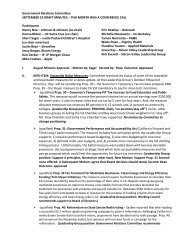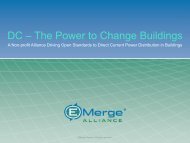CEO Business Climate Survey 2011 - Silicon Valley Leadership Group
CEO Business Climate Survey 2011 - Silicon Valley Leadership Group
CEO Business Climate Survey 2011 - Silicon Valley Leadership Group
You also want an ePaper? Increase the reach of your titles
YUMPU automatically turns print PDFs into web optimized ePapers that Google loves.
SILICON VALLEY<br />
<strong>CEO</strong><br />
SURVEY<br />
BUSINESS<br />
CLIMATE<br />
<strong>2011</strong><br />
Healthcare Reform<br />
Pension Reform<br />
SILICON VALLEY<br />
<strong>CEO</strong><br />
SURVEY<br />
BUSINESS<br />
CLIMATE<br />
<strong>2011</strong><br />
Healthcare Reform<br />
Healthcare reform has gripped the nation for the past two years, leading to passage of the Patient Protection and Affordable<br />
Care Act of 2010. <strong>Survey</strong> participants were asked about the new legislation. Those with opinions approved the new healthcare<br />
law by a margin of about 3-to-2. More than one third of the respondents expressed no opinion, possibly because the law will not<br />
be fully phased in until 2014.<br />
Which of these statements is closest to your feelings about<br />
the Patient Protection and Affordable Care act of 2010<br />
Repeal it - 26%<br />
Keep it - 38%<br />
No opinion/ no answer - 36%<br />
Healthcare costs have stabilized in most local companies, according to the <strong>2011</strong> survey. When asked about the percent of total<br />
business costs that are attributable to healthcare, the replies to the current survey are almost identical to the replies in 2010.<br />
What percent of your total business<br />
costs are attributable to healthcare?<br />
Pension Reform<br />
With decreasing resources available for major public policy<br />
commitments, the sizes and types of government pensions have<br />
come under scrutiny. As of December 31, 2010, more than<br />
500,000 retirees received pensions from CalPERS, the state’s<br />
largest pension program. In addition, the program contained<br />
nearly 1.2 million active and inactive members. 10 One recent<br />
independent analysis places California’s pension obligations<br />
at more than $500 billion, with the gap growing every year. 11<br />
Bearing in mind the state’s ongoing revenue and spending<br />
problems, the <strong>2011</strong> <strong>CEO</strong> <strong>Business</strong> <strong>Climate</strong> <strong>Survey</strong> asked<br />
participants a series of questions on the pension issue.<br />
Respondents were asked whether their companies have<br />
pension programs, and if so, what type. The overwhelming<br />
majority of companies responding (80 percent) have pensions,<br />
with most offering an “undefined,” 401(k)-type plan which<br />
means that the return (or value) fluctuates with the value of the<br />
investment (e.g., stocks, mutual funds). Almost all government<br />
pensions are in the “defined” format, which means that the<br />
retiree gets a fixed amount for the life of the pension, regardless<br />
of market conditions.<br />
Regarding employee retirement, does your company<br />
offer an employee pension plan and if so, what type?<br />
The survey also asked whether governments should stay with<br />
defined pension plans or shift to undefined pensions. By a<br />
margin of 9-to-1, respondents opted for undefined plans.<br />
Most federal, state and local governments<br />
offer defined pension plans. Should they:<br />
Keep defined plans - 7%<br />
Shift to undefined plans, similar to a 401(k) - 71%<br />
Eliminate all pensions - 7%<br />
Don’t know/ no answer - 15%<br />
Along with the question on pension type is the issue of how<br />
long an employee should work until he or she qualifies for a<br />
pension. Many state and local government pension programs<br />
vest employees after 5 years, although the amount of the<br />
pension is relatively small. The survey asked how much time<br />
should elapse before an employee qualifies for a minimum<br />
pension. More respondents opted for employment periods of<br />
20 years or more.<br />
<strong>2011</strong><br />
2010<br />
Yes, Defined benefits - 15%<br />
How long should a public employee work for his/her<br />
government entity before qualifiying for a pension?<br />
30%<br />
23%<br />
27%<br />
7% 7%<br />
11%<br />
3% 2%<br />
29% 25%<br />
14%<br />
23%<br />
Yes, undefined benefits (e.g., 401(k)s) - 63%<br />
No benefits - 22%<br />
Don’t know/ no answer - 2%<br />
5 years - 12%<br />
10 years - 11%<br />
15 years - 6%<br />
1 - 5%<br />
6 - 10%<br />
11 -15%<br />
16 - 20%<br />
Over 20%<br />
Don’t know/ no answer<br />
*Note: Percentages total more than 100<br />
because a few respondents answered “yes”<br />
to both defined and undefined plans.<br />
20 years - 17%<br />
25 years - 27%<br />
Don’t know / no answer - 27%<br />
10 CalPERS, “Facts At a Glance: Retirement & Membership,” February <strong>2011</strong>.<br />
11 “Analysis of California pensions Finds Half-Trillion Dollar Gap,” The New York Times,<br />
April 6, 2010.<br />
13 Healthcare Reform<br />
Pension Reform<br />
14



